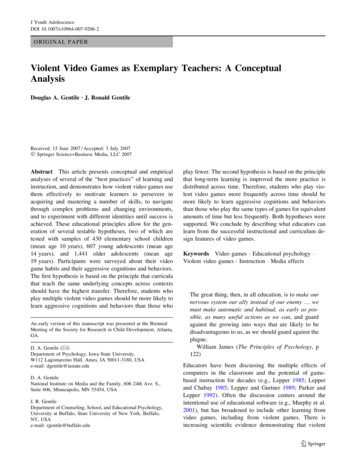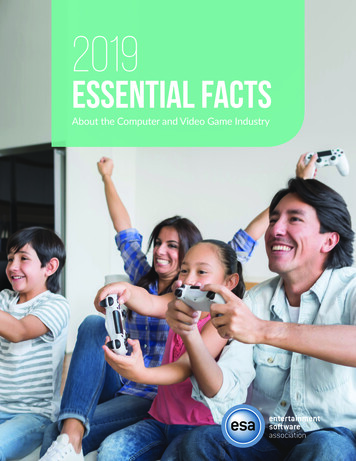
Transcription
J Youth AdolescenceDOI 10.1007/s10964-007-9206-2ORIGINAL PAPERViolent Video Games as Exemplary Teachers: A ConceptualAnalysisDouglas A. Gentile Æ J. Ronald GentileReceived: 15 June 2007 / Accepted: 3 July 2007 Springer Science Business Media, LLC 2007Abstract This article presents conceptual and empiricalanalyses of several of the ‘‘best practices’’ of learning andinstruction, and demonstrates how violent video games usethem effectively to motivate learners to persevere inacquiring and mastering a number of skills, to navigatethrough complex problems and changing environments,and to experiment with different identities until success isachieved. These educational principles allow for the generation of several testable hypotheses, two of which aretested with samples of 430 elementary school children(mean age 10 years), 607 young adolescents (mean age14 years), and 1,441 older adolescents (mean age19 years). Participants were surveyed about their videogame habits and their aggressive cognitions and behaviors.The first hypothesis is based on the principle that curriculathat teach the same underlying concepts across contextsshould have the highest transfer. Therefore, students whoplay multiple violent video games should be more likely tolearn aggressive cognitions and behaviors than those whoAn early version of this manuscript was presented at the BiennialMeeting of the Society for Research in Child Development, Atlanta,GA.D. A. Gentile (&)Department of Psychology, Iowa State University,W112 Lagomarcino Hall, Ames, IA 50011-3180, USAe-mail: dgentile@iastate.eduD. A. GentileNational Institute on Media and the Family, 606 24th Ave. S.,Suite 606, Minneapolis, MN 55454, USAJ. R. GentileDepartment of Counseling, School, and Educational Psychology,University at Buffalo, State University of New York, Buffalo,NY, USAe-mail: rgentile@buffalo.eduplay fewer. The second hypothesis is based on the principlethat long-term learning is improved the more practice isdistributed across time. Therefore, students who play violent video games more frequently across time should bemore likely to learn aggressive cognitions and behaviorsthan those who play the same types of games for equivalentamounts of time but less frequently. Both hypotheses weresupported. We conclude by describing what educators canlearn from the successful instructional and curriculum design features of video games.Keywords Video games Educational psychology Violent video games Instruction Media effectsThe great thing, then, in all education, is to make ournervous system our ally instead of our enemy wemust make automatic and habitual, as early as possible, as many useful actions as we can, and guardagainst the growing into ways that are likely to bedisadvantageous to us, as we should guard against theplague.William James (The Principles of Psychology, p122)Educators have been discussing the multiple effects ofcomputers in the classroom and the potential of gamebased instruction for decades (e.g., Lepper 1985; Lepperand Chabay 1985; Lepper and Gurtner 1989; Parker andLepper 1992). Often the discussion centers around theintentional use of educational software (e.g., Murphy et al.2001), but has broadened to include other learning fromvideo games, including from violent games. There isincreasing scientific evidence demonstrating that violent123
J Youth Adolescencevideo games are linked to increases in aggressive cognitions, feelings, and behaviors (e.g., Anderson and Bushman2001; Anderson 2004; Anderson et al. 2007; Gentile andStone 2005). However, there is still much resistance to theevidence among the public and by the video game industry(e.g., Entertainment Software Association 2007). However,if (as we will argue) violent video games use techniquesthat we know are effective pedagogy, then it is disingenuous to continue to claim that violent video games have noeffects. The goal of this article is to demonstrate two issues: first, how violent video games use many of the bestpractice principles of learning and instruction, and second,what we might learn from the successes of the video gamecurricula that might transfer to our official scholastic curricula. We intend this to be primarily a conceptual article,but we have included some data to demonstrate the utilityof these concepts for hypothesis generation and testing.games include violent content (Children Now 2001), withabout half including violence against others culminating inserous injury or death (Children Now 2001; Dietz 1998;Dill et al. 2005). Furthermore, because the average age ofgamers has risen, many parents have likely becomedesensitized to violent content and may be less likely tomonitor children’s games. This progression almost seemsinevitable. By inventing educational and entertaininggames for preschoolers and then slowly but surelyincluding more and more need for ‘‘viewer discretion,’’ theindustry trains people to be accepting—emotionally, cognitively, and behaviorally—of violent video games. Mostconsumers are not conscious of the learning principlesunderlying this progression, but the developers and marketers probably are, if only by realizing that they need tokeep creating games that outdo previous games in order tocapture a larger share of the market.Playing the GameSeven Exemplary Dimensions of Video GamesAmong elementary and middle school populations, girlsplay video games for an average of about 5.5 h/week andboys average 13 h/week (Anderson et al. 2007; Gentileet al. 2004). In a nationally representative sample, parentsreported that their young children aged two to seven playan average of 43 min/day (Gentile and Walsh 2002), andWoodard and Gridina (2000) reported that preschoolersaged 2–5 play an average of 28 min/day. Comparing thesedata with previous studies shows that the amount of timespent playing video games is increasing, but not at theexpense of television viewing which has remained stable(Gentile and Anderson 2003). Although most children playvideo games, the average age of video game players hassteadily risen to age 33, demonstrating that many childrencontinue playing into adulthood (Entertainment SoftwareAssociation 2007).Data about children’s amount of time spent playing videogames are content-independent and, like the data on television watching, are correlated with many other risk factors forhealth such as obesity (Berkey et al. 2000; Subrahmanyamet al. 2000; Vandewater et al. 2004) as well for poorer academic performance (e.g., Anderson and Dill 2000; Andersonet al. 2007; Gentile et al. 2004; Harris and Williams 1985).When video game play is analyzed for violent content,additional risk factors are observed for aggressive behaviorand desensitization to violence (again in parallel with thedata on viewing violent television; e.g., Anderson and Dill2000; Anderson et al. 2003, 2007; Bartholow et al. 2006;Carnagey et al. 2007; Gentile 2003; Gentile et al. 2004).As the entertainment industries regularly point out,viewer discretion and parental monitoring are advised. Yet,most parents do not know that as many as 89% of videoOur goal here is to enumerate the ways video games systematically and effectively use educational principles oflearning, cognition, and instruction. The research isbecoming increasingly clear that violent video games cancause people to have more aggressive thoughts, feelings,and behaviors (for recent meta-analyses of the literature,see Anderson and Bushman 2001; Anderson 2004), yet thisset of findings is still considered ‘‘controversial.’’ Videogames themselves are becoming increasingly sophisticated(e.g., Poole 2000; Provenzo 1991) to the point that theviolence simulated in such games as Doom II have beenadopted by the military to train marine combat units(Provenzo 2003), who obviously believe in the educationalbenefits that will result. Video games are excellent teachersalong several dimensions (see also Gee 2003, for his list of36 learning principles exemplified by video games).First, the games have clear objectives, often set atmultiple difficulty levels (1) to adapt to the prior knowledge and skills of each learner and (2) the pace of eachlearner (faster or slower, novice or expert). Inventing waysof matching objectives and pace to the capabilities oflearners is no small accomplishment, since it is central tomost if not all models of instruction, from Glaser’s (1962)and Hunter’s (1982) specification of objectives at the correct level of difficulty to Carroll’s (1963, 1989) concept ofaptitude as the time needed to learn to an establishedstandard of mastery. Moreover, there is empirical evidencethat for many memory tasks the average learning rate of thetop third of any class is at least three times faster than thebottom third, with the fastest and slowest learners in thesame class differing by even larger multiples (e.g., Gentileand Lalley 2003; Gentile et al. 1995).123
J Youth AdolescenceThe second dimension along which video games excel isthat they require learning to be active with practice, feedback, and more practice to the point of mastery (e.g., Gee2003). This is in contrast to much classroom learning inwhich teachers lecture on or demonstrate a concept or skill,then take questions, if any, and move on to cover othermaterial. However, as is well known in the development ofskills such as sports or music, learners will likely developgood questions only after attempting to do what wasdemonstrated. Feedback and corrections operate only then,which in classrooms often happens only much later (e.g.,on a unit test) and thus is too late to be of much help.Practice to the point of mastery—that is, to a higher ratherthan lower standard of accuracy—is predictive of howmuch is remembered later, as well as how much savingswill occur in relearning at a later date (Bahrick 1984;Ebbinghaus 1885 Gentile and Lalley 2003; Semb and Ellis1994; Willingham 2004).Third, once mastered, the knowledge and skills arepracticed further to provide overlearning. With overlearning the knowledge and skills become automatized andconsolidated in memory, so that the learner can begin tofocus consciously on comprehending or applying newinformation. In other words, the novice is beginning toprocess and organize new information with more expertise(Chase and Simon 1973; Chi et al. 1982). Bloom (1986)illustrated this process for reading ability. The buddingreader can recognize whole words easily only afterknowledge of letters and sounds is automatized. Once thereader has achieved a number of ‘‘sight words,’’ then thereader can focus on the meaning of the sentences (Bloom1986).Fourth, mastery of an objective is reinforced bothextrinsically (with points, totals, better weapons, moremoney, more health, etc.) and intrinsically (by advancement to higher levels of complexity and the self-esteemthat accompanies increased competence). This last point isperhaps underappreciated by educators who have been toldto praise often so as to increase children’s self-esteem.Video games teach self-efficacy through increasing mastery. Teachers often offer praise instead of encouragingself-discovery and mastery. A wide range of developmentaltheorists agree that perceived self-efficacy arises fromcompetence or efficacy (Bandura 1977, 1986), and lack ofcompetence leads to learned helplessness (Seligman 1975).Mastering the essential tasks of school is critical for solving the identity crisis of that age (‘‘I am what I can do’’),while the lack of mastery leads to feelings of inferiority(Erikson 1963, 1968, 1980). Vygotsky (1962) also speaksof the ‘‘rupture,’’ ‘‘turning point,’’ or ‘‘struggle’’ that isinvolved in maturation and which is resolved by masteringsociety’s developmental tasks. Piaget’s central motivational construct is ‘‘cognitive conflict,’’ which arises whenthere is a discrepancy between a child’s perception of anevent and disconfirming evidence (e.g., in the conservationof liquids tasks; Piaget and Inhelder 1941). This cognitiveconflict establishes a tension (between assimilation andaccommodation in the equilibrium mechanism), whichproduces the ultimate teachable moment. That is, the childrecognizes what he or she does not understand and is nowready to learn it. Accomplishing this difficult task earnsself-esteem, self-efficacy, and indeed a new identity (when,for example, a non-reader is now a reader). Gee takes thesetraditional theories a step further in suggesting that videogames require and reinforce a player’s commitment of‘‘time, effort and active engagement’’ in such a way thatthey can experiment with identities and eventually ‘‘ seethemselves as the kind of person who can learn, use, andvalue ’’ what is being learned (2003, p. 59). Wouldn’t wewish, he continues, to have our students trying on a scientist identity in our science classes?Fifth, and related to the fourth, video games are wellsequenced in levels of increasing difficulty, complexity orpace, with success at subsequent levels contingent uponcompetencies mastered at previous levels. Consider theexample of the popular first-person-shooter game1 Halo.For the first hour of play, the game not only sets up thestory (you are a warrior, in a science fiction future, savinghumans from attacking aliens), but also teaches you how toplay. The game characters and spaceship computer teachyou systematically which control buttons to use to lookaround, to walk, to crouch, to jump, to pick up weapons, toreload, etc. This is necessary partly because of the complexity of the game controller (13 buttons, joysticks, pads,and triggers), but after teaching a specific skill, the gameimmediately gives you a chance to practice it. Then thegame provides immediate feedback, including adapting toyour specific skill using the controller. For example, thefirst author had difficulty with the joystick in looking upand down—it was more ‘‘natural’’ to pull back to look upand push forward to look down (as one would in an airplane). This was contrary to the default settings on thegame. The game noticed this, inverted the joystick controlsto fit the author’s predilection, and asked if this was better.Over the course of the first hour of play, a series of skillsare taught systematically, with feedback and opportunitiesfor practice, until one has learned several skills necessary1A ‘‘first-person-shooter’’ game is one in which the action is seenfrom the point of view of the main character. Usually the player seesas if he/she was ‘‘in’’ the game, so when you hold a gun in front ofyou, you see the barrel of the weapon and sometimes the hand holdingit. The ‘‘shooter’’ part of the definition is self-evident. This type ofgame can be distinguished from other violent games in which theaction is seen from a distance (a third-person perspective). Firstperson-shooters have become so popular, they are now known by thattitle as a distinct genre of game.123
J Youth Adolescencefor successful game play (such as how to use the information shown on the display, when to reload, and how tosneak up behind one’s prey for silent kills).This fifth dimension is the embodiment of the spiralcurriculum (Bruner 1960), in which each learning objectivehas identifiable prerequisites which, when mastered, facilitate transfer to the next level of difficulty. Thus, learnerscome to see mastery of an objective not as the completionof a learning objective, or ‘‘benchmark’’ in current educational lingo, but rather mastery is properly conceived asthe beginning (Gentile and Lalley 2003). You are nowready to use that knowledge or skill in some meaningfulway on the road toward expertise. Video games do notachieve exemplary spiral curricula by ‘‘making the gamesshorter and simpler to facilitate learning’’ as schools oftendo (Gee 2003, p. 6). Rather, they make the games longer,more complex, and harder, requiring (as noted above) moreinvestment of time, effort, activity, and reflection.Sixth, because video games are adaptable in level of difficulty and pace, they encourage a close-to-optimal combination of massed and distributed practice. Initial attempts atthe game, no matter how abysmal, receive feedback or ascore immediately and few can resist trying again and againuntil they begin to show progress. Such massed practiceeventually begins to produce diminishing returns (when aplateau is reached or fatigue sets in); however, the repetitionhas begun to develop both physical and mental skills andhabits on parts of the task (e.g., eye-hand coordination,knowledge of what is required, etc.), always in the context ofthe whole sequence. Each subsequent encounter with thegame provides the memory benefits of distributedpractice—relearning anything that was forgotten, providingnew cues for memory, interpreting new information orexamples with what is already in memory and reorganizingthe memory accordingly. This combination of massedpractice to build sufficient initial mastery to play the game,followed by distributed practice over days or weeks to prevent forgetting is optimal for the development of automatized structures of knowledge, or schemas (e.g., Ellis andHunt 1993; Anderson 1983; Glaser 1984).Seventh, knowledge or skills learned and practiced inmultiple ways on several problems, or in a variety of contexts, are more likely to transfer than when practiced in onlyone way on a single kind of problem, or in the same context.One reason for this is suggested by Bransford et al. (1999):‘‘with multiple contexts, students are more likely to abstractthe relevant features of concepts and develop a more flexiblerepresentation of knowledge’’ (p. 66). Multiple contexts alsoprovide a variety of cues for recall rather than memoryhaving to rely on availability of cues from the original context or problem situation—what Tulving and Thompson(1973) called the encoding specificity principle and Brownet al. (1989) called situated cognition.123Multiple ways of solving problems or performing skillsalso avoid the mental sets or rigidities that naturally arisefrom success with a particular method (e.g., Luchins 1942).Learning multiple ways of representing division of fractions is more likely to lead to greater comprehension thanthe same amount of time spent simply practicing the ‘‘invert and multiply’’ algorithm. Returning to video games,this is likely to be one of the reasons violent video gameshave shown effects on aggressive thoughts, feelings, andbehaviors (e.g., Anderson 2004). Violent video games areset in many contexts: some are set in historical times, someare modern, some are very realistic, some are cartoonish,some are futuristic, etc. The games also employ a variety oftools: hand-to-hand combat, small arms, military weapons,laser guns, and one popular game even uses a golf club as alethal weapon. The common feature among all of thesedifferent games and contexts is that violence is the solutionto whatever problem the gamer/student faces. This is exactly the best way to teach so that the student will be ableto transfer the underlying concept to new situations.In addition to the above well-known principles of educational instruction, video game producers also use timehonored ‘‘tricks’’ that have been well-known by the mediaand advertisers. For example, Kubey and Csikszentmihalyi(2002) describe how the ‘‘orienting response,’’ first described by Ivan Pavlov, has been used to increase attentionto television ads. Visual or auditory changes, such as editsthat change the angle of camera view or sound effects,make us look at them. Increasing the frequency of edits hasbeen shown to improve recognition memory (up to apoint there is an optimal level). Furthermore, provocativescenes of sex and violence not only capture one’s attention,but also supply vivid visual images, which are known tocreate better memory than the same information providedverbally (e.g., Paivio and Begg 1981). Active participationin aggressive or provocative scenes in video games increases physiological arousal (e.g., Ballard and Weist1996; Gwinup et al. 1983; Lynch 1999; Murphy et al.1992; Segal and Dietz 1991). This physiological responding in the context of ‘‘playing fun games’’ is likely tocondition one’s emotions to such activities, not unlike otheraddictive ‘‘highs.’’ Indeed, there is some research demonstrating that the brain releases dopamine in response toplaying violent video games (Koepp et al. 1998). Dopaminergic neurotransmission may also be involved inlearning, reinforcement of behavior, attention, and sensorimotor integration as well (Smith et al. 1999). Because thedifficulty of the games, which varies as one progresses,guarantees that reinforcement will be intermittent, notcontinuous, games take full advantage of the addictivenature of intermittent reinforcement (e.g., slot machines).Finally, these games are marketed widely as cool, andsomething everyone must have. One of the roles mass
J Youth Adolescencemedia play in youth and adolescence is as a way of definingoneself (Christenson and Roberts 1998). For example,adolescents often define their cliques by musical style (e.g.,Goths, hip-hop, metalheads, punks, etc.; Christenson andRoberts). Visit any school playground, and much of thediscussion and play will be about media characters, movies, TV shows, and video games. Partly because videogames are so popular and motivating (Bryant and Vorderer2006), skill in such games is an important social currencyfor popularity among children (especially among boys).HypothesesNote that each of the educational aspects described aboveprovides testable hypotheses about how to create effectiveeducational software. Although these learning principlesare well-established in the classroom, few of thesehypotheses have yet to be tested with regard to videogames or other media. Nevertheless, there is a large andgrowing body of evidence showing that the more exposureconsumers have to media, the more likely they are to learnfrom those media—including areas as diverse as productrecognition, specific knowledge, skill development, attitude formation and change, stereotypes, brand purchasingand loyalty, and aggressive beliefs and behaviors. Some ofthese lessons are intentional, such as educational softwareor television programs designed to teach reading skills, andsome are unintentional, such as violent games or televisionprograms training aggressive behavior.Two of the testable hypotheses from the educationalprinciples described above were addressed here. First, theseventh principle above states that curricula that teach thesame underlying concepts across contexts and domainshave the best likelihood of transfer. Therefore, studentswho play multiple violent video games are more likely tolearn aggressive cognitions and behaviors than studentswho generally play fewer violent video games. Second, thesixth principle above states that learning is more likely tobe long-term if practice is distributed across time, in contrast to massed practice (our students know this as‘‘cramming’’). Therefore, students who play violent videogames more regularly are more likely to learn aggressivecognitions and behaviors than students who play less regularly even if they play for equal amounts of time.MethodsParticipantsThree sets of data were collected, one with elementaryschool children in grades 3–5, one with young adolescentsin grades 8 and 9, and one with late adolescents enrolled ina large Midwestern university. For the elementary schoolsample, 430 3rd (N 119), 4th (N 119), and 5th grade(N 192) students participated in the study. Students wererecruited from five Minnesota schools, including one suburban private school (N 138), three suburban publicschools (N 265), and one rural public school (N 27).The sample was almost evenly divided between boys andgirls, with 51% of the children being male. Participantsranged in age from 7 years to 11 years of age (M 9.65;SD 1.03). Eighty-six percent of the respondents classified their ethnic background as Caucasian, which is representative of the region (other ethnicities included 2%African American, 2% Latino/Hispanic, 1% NativeAmerican, 4% Asian, 2% Multi-Racial, 2% other). Allparticipants provided parental consent and assent.For the young adolescent sample, 607 8th-grade(N 496) and 9th-grade (N 111) students participated inthe study. Students were recruited from four Minnesotaschools, including one urban private school (N 61), twosuburban public schools (N 350), and one rural publicschool (N 196). Students were recruited from mandatoryclasses within their schools. The mean age of respondentswas 14 years (SD .64). Fifty-two percent of respondentswere male. Eighty-seven percent of the respondents classified themselves as Caucasian (other ethnicities included1% African American, 2% Latino/Hispanic, 1% NativeAmerican, 3% Asian, 5% Multi-Racial, 1% other). Allparticipants provided parental consent and assent.For the late adolescent college sample, 1,441 studentsparticipated in the study. Students voluntarily participatedin mass testing sessions, and earned extra credit points fortheir introductory psychology classes. The mean age ofrespondents was 19.4 years (SD 1.73). Forty-five percentof respondents were male. Eighty-nine percent of therespondents classified themselves as Caucasian, which isrepresentative of the region and university populations(other ethnicities included 3% African American/Black,2% Latino/Hispanic, 0% Native American, 4% Asian, 1%Multi-Racial, 1% other). All participants provided informed consent. All samples were treated in accordancewith the ‘‘Ethical Principles of Psychologists and Code ofConduct’’ (APA, 1992).Elementary Longitudinal Sample ProcedureParticipants completed three confidential surveys, andteachers completed one survey for each participating child(described below). Each participant (including teachers)completed each of these surveys at two points in timeduring the school year. The first administration (Time 1)occurred between November and February of the academicyear. The second administration (Time 2) occurred123
J Youth Adolescencebetween April and May of the year. The average time lagbetween the two administrations was 5 months. Consentlevels were at least 70% for all classrooms, each of whichwas a mandatory class to reduce the likelihood of selectionbias. Additional details of the procedure and instrumentsare available in Anderson et al. (2007). It is worth notingthat all of the data gathered here were guided by the theoretical framework of the General Aggression Model (seeCarnagey and Anderson 2003; Anderson and Huesmann2003 for details).Assessment of Social AdjustmentPeer Assessment of Social Adjustment A peer nominationinstrument was used to assess children’s social adjustment,and was adapted from a peer nomination instrument thathas been used in several previous studies of children’ssocial behavior (e.g. Crick 1995; Crick and Grotpeter1995). Only the physical aggression scale (2 items) is reported here. Children were asked to nominate three children who hit or kick others or who push and shove othersaround. Coefficient alpha was computed and was found tobe satisfactory (a .92).Teacher Ratings of Aggressive Behavior Teachers completed a survey assessing children’s aggression and prosocial behavior (Gentile et al. 2004). For the purposes ofthis study, only the physical aggression subscale was used.This subscale asks teachers to rate on a five-point scalewhether the target child hits or kicks peers, initiates or getsinto physical fights, threatens to hit or beat up peers, andpushes or shoves peers (anchored ‘‘never true’’ and ‘‘almostalways true’’). Coefficient alpha was satisfactory (a .92).Self-report of Fights One item asked children whetherthey had been involved in a physical fight in the schoolyear.Assessment of Media HabitsViolent Video Game Exposure Similar to Anderson andDill’s (2000) approach, participants were asked to nametheir three favorite video or computer games. For eachnamed video game, participants were asked to rate howfrequently they played on a 5-point scale (1 ‘‘Almostnever,’’ 5 ‘‘Almost every day’’). Participants were alsoasked to rate how violent they consider each media productto be on a 4-point scale (1 ‘‘Not at all violent,’’4 ‘‘Very violent’’).Weekly Amount of Video Game Play Participantsreported the amount of time they spent playing videogames during different time periods (from when they wake123up until lunch, lunch until dinner, and dinner until bedtime), separately for weekdays and weekends. Weeklyamounts were calculated from these responses.Assessment of Hostile Attribution Bias/Social InformationProcessingThe final survey was an adapted version of a hostile attribution survey that has been reliably used in past research(e.g., Crick 1995; Nelson and Crick 1999). This instrumentcomprises 10 stories, each describing an instance of provocation in which the intent of the provocateur is ambiguous. Participants answer two questions following eachstory. The first presents four possible reasons for the peer’sbehavior, two of which indicate hostile intent and two reflect benign intent. The second question asks whether theprovocateur(s) intended to be mean or not. This surveyassesses the participant’s perception of hostility from theoutside world. Based on procedures delineated by Fitzgerald and Asher (1987), the children’s responses to theattribution assessments were summed across the stories.Coefficient alpha was satisfactory (a .85).Composite Measures A composite measure of physicalaggression was created because we had multiple informants. Peer ratings of physical aggression, teacher ratingsof physical aggression, and self-reports of physical fightswere standardized and averaged to create a physicalaggression composite. Coefficient alpha was computed andfound to be satisfactory at both points in time (Time 1a .87, Time 2 a .89).Young Adolescent Sample ProcedureEach participant completed an anonymous survey packet.Consent levels were greater than 90% f
National Institute on Media and the Family, 606 24th Ave. S., Suite 606, Minneapolis, MN 55454, USA J. R. Gentile Department of Counseling, School, and Educational Psychology, University at Buffalo, State University of New York, Buffalo, NY, USA e-mail: rgentile@buffalo.edu 123 J Youth Adolescence DOI 10.1007/s10964-007-9206-2.










